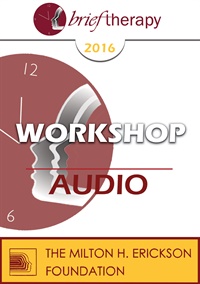BT16 Workshop 41 - Informational Trance Induction in Couple Therapy: Partners in a Pose - Stan Tatkin, PsyD, MFT
- Average Rating:
- Not yet rated
- Topic Areas:
- Workshops | Couples Therapy | Hypnotic Induction | Trance
- Categories:
- Brief Therapy Conference | Brief Therapy Conference 2016 | Pioneers in Couples and Family Therapy
- Faculty:
- Stan Tatkin, PsyD, MFT
- Duration:
- 2:58:09
- Format:
- Audio Only
- Original Program Date:
- Dec 11, 2016
- License:
- Never Expires.
Description
Description: This workshop (the second of two) introduces the use of informal trance and rolling chairs in couple therapy to support arousal regulation and deeper relational work. It also showcases body-based techniques like the "Lovers Pose" and "King and Queen" exercises. Drawing from the Psychobiological Approach to Couple Therapy (PACT), it demonstrates how stationary positioning, eye contact, and right-brain engagement access implicit memory and deepen emotional connection. Through live and video demonstrations, participants learn to manage arousal, shift power dynamics, and guide couples toward secure attachment and healing.
Syllabus Description: This second of two workshops will demonstrate the use of informal trance in couple therapy. PACT therapists use of posing (partners holding stationary positions) as a major therapeutic tool for both the couple and therapist in managing arousal, attention, and for inducing trance states. Attendees will learn a common PACT approach to inducing informal trance states in partners using what’s been termed, The Lovers Pose. Partners go into a deeper state whereby the therapist can probe, prod, and investigate more implicit issues that plague the relationship. Attendees will view clinical video demonstrations as well as live demonstrations to further illustrate this technique.
Educational Objectives:
- Apply the technique of lovers pose in their office.
- Apply interventions using cross-questions, cross-interpretations, going down the middle, and bending metal.
- Use at least two ways of getting the couple into a trance state using continuous eye contact, voice, and cross-questions.
- Apply at least two psychodramatic skills that include casting and staging.
- Analyze partner response by reading the face, eyes, voice, heart rate, and body movements.
*Sessions may be edited for content and to preserve confidentiality*
Credits
Handouts
| Ericksonian Learning Snapshot (249.6 KB) | 2 Pages | Available after Purchase |
Faculty

Stan Tatkin, PsyD, MFT Related Seminars and Products
Stan Tatkin, PsyD, MFT, is a clinician, researcher, teacher, and developer of A Psychobiological Approach to Couple Therapy (PACT®). He has a clinical practice in Calabasas, CA, where he has specialized for the last 15 years in working with couples and individuals who wish to be in relationships. He and his wife, Tracey Boldemann-Tatkin, developed the PACT Institute for the purpose of training other psychotherapists to use this method in their clinical practice.
Reviews
Rating: Not yet rated


